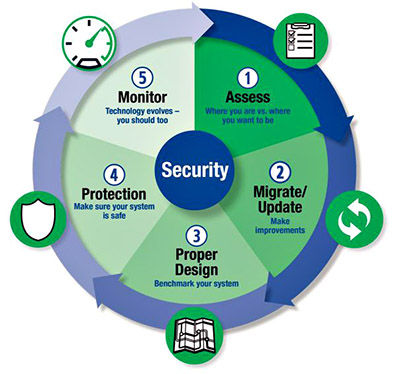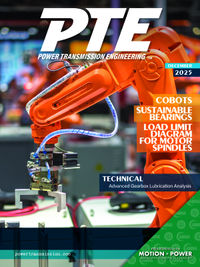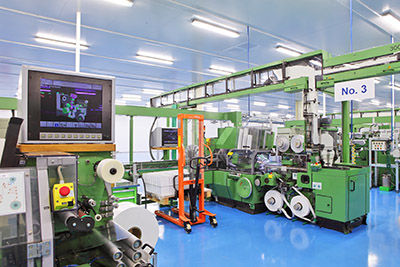Another of the Industrial Internet’s
main focuses is in the field of predictive
maintenance. Right now, most
maintenance is reactive. Technicians
might check the oil level every now
and then, but unless a machine grinds
to a halt, no one’s about to halt production
to go digging through its guts and make sure a gear isn’t fracturing
or a brake pad hasn’t worn down. At
best, most companies do standard,
periodic maintenance and have replacement
parts on hand if something
does go awry.
The Industrial Internet looks to
revolutionize that entire process. Machines
will be able to monitor their
own condition and give early warning
for everything from when the oil
gets low to when vital parts are on the
verge of failing. By putting sensors in
machinery and allowing them to constantly
monitor themselves, we allow
them to in turn give technicians more
information more quickly than an
entire team of dedicated professionals
could ever hope to. Maintenance
would become more proactive and
comprehensive than ever before.
Big Data rounds out many of the
Industrial Internet’s advances. Manufacturers
can analyze their entire
history of production and pick out
patterns of everything from specific
issues that could be improved upon to
unexpected markets they’re appealing
to. For example, a car manufacturer
could look across all its various
car lines and identify which cars broke
down the most consistently. From
there, they could look at a list of all
the reported ways those specific cars
failed and see what’s causing them to
fail, be it a single part that wasn’t quite
up to snuff or a larger issue.
And so on and so forth, the manufacturer
could continue digging deeper
for as long as there’s data to continue
delving into, identifying points
of improvement that would have been
invisible before by computing sums of
data so vast that they’re impossible for
an actual person to analyze.
America’s Initiatives
Currently, the US is one of the leading
nations when it comes to the Industrial
Internet. Research and development
is keeping pace with other
leading countries in the field. Right
now, there are two primary initiatives
spearheading the effort: the Industrial
Internet Consortium (IIC) and the
Digital Manufacturing and Design Innovation
Institute (DMDII).
The IIC is, according to their website,
an “open membership, international
not-for-profit consortium that is setting
the architectural framework and
direction for the Industrial Internet.”
They were founded in 2014 and are
headed by AT&T, Cisco, GE, IBM and
Intel. The IIC’s main mission is to be
a focal point for organizations, institutions
and businesses interested in the
Industrial Internet to get together and
develop a common dialect and some
standards. Different working groups
in the IIC do everything from overseeing
testbeds to spreading awareness
about the Industrial Internet.
One of the IIC’s contributing members,
Belden, has been in the Industrial
Internet game since before it had
a dozen buzzword names and has had
the unique opportunity to watch it develop
from the start.
“We see a number of things that are
changing,” Jeff Lund, senior director of
product line management at Belden’s
Industrial IT Division said. “I think of
the changes as occurring across two
axes, horizontally within the control
systems and vertically within the business.

Belden Inc. recommends a fivestep
approach to understanding
and implementing the Industrial
Internet of Things.
- Click image to enlarge
“Horizontally within the control
system, what we see with the Industrial
Internet is that the use of industrial
internet technologies is penetrating
deeper and deeper into control
systems, displacing legacy protocols
and technologies and hardwired systems.
In IIoT terms, you can think of
us as connecting more and smaller
things – moving from the connected
factory (one big thing), to connected
machines (more and smaller things),
to connected controllers, and eventually
to connected sensors and controllers.
With each step the number of
things grows by an order of magnitude
or more.
“Vertically within the business,
what we see is a move toward more
and more integration between business
systems and the data flowing into
and out of industrial control systems –
what is often called IT/OT integration.
Big data and analytics are also part of
this trend. The overarching theme is
that the data within control systems
that has historically been used just
for the operation of the system itself
also contains a wealth of useful information
that when made available to
business systems can be used to drive
a wide range of new efficiencies (better
asset utilization, lower energy consumption,
better supply chain management,
etc.), along with other cost
savings and revenue enhancements
(predictive maintenance, manufacturing
as a service, etc.).”
Amongst other efforts, Belden
joined the IIC in July and has already
involved itself in several of the IIC’s
working groups. Though their main
focus is the security working group, they’ve involved themselves with numerous
different sections of the IIC,
from marketing to testbeds.
“The IIC has been great to work
with,” Lund said. “It is a very transparent
and professional organization.
Communication between IIC
staff and between IIC members is
very open and collaborative and the
group is good at working together to
get things done.”
On the R&D side of things, the DMDII
opened this May. With $70 million
of backing from the government,
the DMDII is working with dozens of
partners to further study in almost
every field of the Industrial Internet,
from cybersecurity to developing
Cloud services for CNC machining. In
its first year, the institute has greenlit
five projects and has another 15 under
consideration.
The DMDII is part of a broader
initiative being pushed by President
Obama, the National Network
for Manufacturing Innovation, that
is focused on upgrading America’s
industrial sector through universal
technology improvements such as the
Industrial Internet. It stands alongside other institutes such as America
Makes, LIFT, and Power America.
Future Steps
Despite the flocks of supporters behind
the Industrial Internet, the
movement’s only a few years old and
there are still serious issues that need
addressing.
Foremost amongst them is the need
for standardization. Much of the technology
behind the Industrial Internet
is heavily dependent on machines being
able to communicate with each
other, but two machines from different
manufacturers that speak entirely
different languages will not be able to
work in tandem or transfer data. It is
imperative that a framework of standards
be introduced to ensure that as
many different machines are compatible
with each other as possible. Otherwise,
the potential effects of Industry
4.0 will be severely blunted.
On the flip side, the more standardized
the system becomes, the more
data people will have access to. Machines
could do more than just talk
to each other, they could access data
from other manufacturing plants.
With set standards, datasets could
potentially cross over between continents
and companies alike.
After a basic framework comes
network security. While those buzzwords
may summon up images of
code-slinging hackers coming to steal
your data and make all your newlyinterconnected
machines go haywire,
they actually aren’t your main concern.
According to an infographic put
out by the IIC in October, hackers are
actually in the minority when it comes
to internet breaches. Only 20 percent
of cyber “attacks” were intentional,
brought about by a hacker or otherwise.
Far more often, the problem
could be attributed to malware (30.4
percent), system or software malfunction
(38.4 percent) or user error (11.2
percent), and while hackers may be
slowly becoming the boogeymen of
the internet, the far more common issue
is unintentional internet breaches.
Another primary issue will be education
and employment. One of the
major issues facing the industry today
is the lack of educated workers entering
the workforce, and the Industrial
Internet will only exacerbate this
problem. While the Industrial Internet
will continue the trend of obsoleting
repetitive, manual labor, it will be
producing just as many new positions
overseeing and maintaining machinery.
The only potential issue? The manual
labor workers that are being displaced
might not have the training
to return to the industry and take up
these new, more specialized jobs. A
2012 report from the U.S. Bureau of
Labor found that only 18.7 percent of
the manufacturing workforce has a
bachelor’s degree or higher. 45.6 percent
haven’t had any college experience.
And while these numbers are an
improvement from previous years and
a bachelor’s isn’t necessarily required
to perform the new jobs the Industrial
Internet will create, much of the workforce
will have to learn new skills to
stay in the industry, which means that
laying out a framework to get them
the knowhow they need will be paramount.
Willing, but not Quite Ready
Going back to Infosys’s report, the Industrial
Internet may be on the rise,
but it still has a long way to go. Out of
433 companies surveyed in the US,
Germany, China, the UK and France,
85 percent of companies are aware of
Industry 4.0’s potential, but only 15
percent have fully implemented strategies
to take advantage of the Industrial
Internet’s capabilities. A further
39 percent have started taking steps
towards implementing Industry 4.0
technologies, but they have yet to accomplish
full integration.
A white paper published by Hannover
Messe in January revealed similar
numbers amongst German manufacturers:
84 percent of manufacturers
“believe that Industry 4.0 will provide
a new framework to human labor in
production,” but only 20 percent have
a clear picture of what exactly that
will entail. The DMDII has reported
similar numbers, as well, reporting
on their website that “81 percent of
U.S. manufacturers acknowledged
that digital manufacturing is a key element
in their future competitiveness,
but only 14 percent said they were adequately equipped today with digital
technologies and related expertise.”
The results mirror Infosys’s report.
A lot of people want onboard the Industrial
Internet bandwagon, but the
number of manufacturers actually
implementing it is far smaller.
However, this will probably all
change in the near future. Infosys’s
report showed that while businesses
may not be implementing the Industrial
Internet right this moment, 48
percent of them are taking steps to
ensure that they are fully implemented
by 2020 and another 32 percent
will be in the process of upgrading.
On Your Marks
And as more and more businesses
line up to adopt the Industrial Internet,
the vital question arises: how do
you start your own Industrial Internet
program?
And, more importantly, how do you
keep from being overwhelmed in the
process?
According to both Lund and Cahill,
the main strategy is to pace yourself
and not try to upgrade everything at
once.
“When people think of everything
that the IIoT might touch in
their business over time it can be a
bit overwhelming,” Lund said. “Our
view is that it isn’t really feasible to
say that before you can take your first
step you must be able to foresee everything
you might want to do over
the life of your network - which could
be decades. Rather, we think the key
to building a solid building is to lay a
strong foundation, the key to building
out an Industrial Internet system is
to build a strong network foundation
so that your system can adapt to your
changing business needs.”
Belden’s put together a five step
process (Assess, Migrate/Update,
Proper Design, Protection, and Monitor)
that Lund recommends newcomers
to the Industrial Internet follow.
Step one, assessing, is all about
looking at the current state of your
business and figuring out where you
want to take it. Identifying where you
are and where you want to go can often
highlight the difficulties you need
to overcome and make your approach
much more focused.
“Before you start to build a new
system, you need to understand what
you already have, what its connectivity
(wired/wireless, bandwidth,
reliability) and environment requirements
are, and what your near term
goals are in terms of functionality and
data exchange,” Lund said. “The end
result of the assessment stage should
be an accurate ‘map’ of your network’s
infrastructure.”
After that, the Migrate/Update step
is about looking at any existing legacy
systems you might already have and
can repurpose or upgrade and investigating
what kind of bandwidth and
equipment requirements you’re going
to need to meet. The third step, Proper
Design, is when Belden recommends
taking a step back and making sure
your program meets established best
practices and standards (like, say,
those standards the IIC is striving to
create). Step four, Protection, is when
you focus on system security (one of
Belden’s specialties) which, if you remember,
has as much to do with making
sure your system is accident-proof
as keeping hackers out. Belden recommends
a risk assessment as a good
place to start. Step five, Monitoring,
brings the process full circle.
“The last step is a feedback loop
into the first,” Lund said. “Technology
is constantly changing. Security
threats are changing. Business needs
are changing. Customers need to
monitor all of these things and make
changes to their system accordingly...
IIoT is a journey, not a destination.
These are living systems that
will evolve over time. The key thing,
however, is that if customers follow
the process we’ve outlined and think
about things upfront, the infrastructure
they deploy today will provide
them the solid foundation they need
to build on over time.”
Cahill recommends starting small.
She believes that the best place to
start is with a specific application
or problem the company’s having,
something small and, more importantly,
measurable.
“What we’re really advising people
to do is not to try to take on the whole
beast at one time, if you will,” Cahill
said. “Once that return on investment
is realized, it’s very easy to then grow
it and expand it. The product itself is
very scalable, and companies then
run with it, thinking of all different
other applications that they’d be really
excited to be able to use it in.”
One case study that Orbis supported
involved a company’s shipping
system.
“The company was spending a tremendous
amount of money on trucks
that were sitting idly by waiting to be
loaded at the loading dock,” Cahill
said. “And the management did not
really have a handle on their dayto-
day operations. They knew what
needed to be loaded and what needed
to go out, but they did not have
clear vision down to the minute in
real-time, as to the progress that was
being made with the loading of these
trucks.”
The solution was for Orbis to develop
a program that would follow
the packing process and show it all
on one screen. The manager would
be able to see when trucks were supposed
to leave, what needed to go on
them, and how far into the loading
process the truck was.
“In that instance, [with] a very simple
pilot program, that manager was
able to determine ‘do I let the truck go
partially filled? Do I accrue the added
overtime...or do I know right then at
that second if I need to throw more resources
at the problem?’” Cahill said.
“That kind of real-time information is
essential for people to be able make
resource-efficient decisions.”
Inevitably, each company will implement
the Industrial Internet in its
own way based on its situation, but
there are numerous options on how
to go about upgrading. The important
thing to remember is that not only
should you jump on the Industrial Internet
bandwagon, you also can.
For more information:
Belden
Phone: (800) 125-2261
www.belden.com
Orbis USA
Phone: (703) 734-6494
www.orbisusa.com/en/
About Author
Alex Cannella
Alex Cannella, News Editor, joined PTE in 2015 and is the current News Editor.








